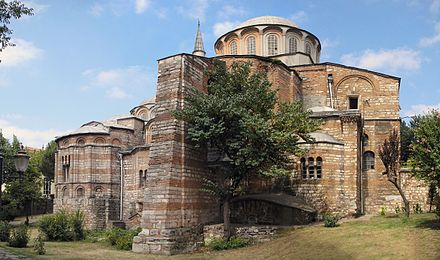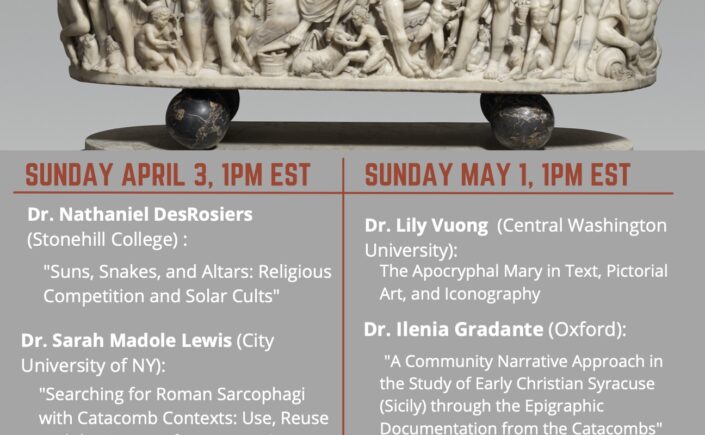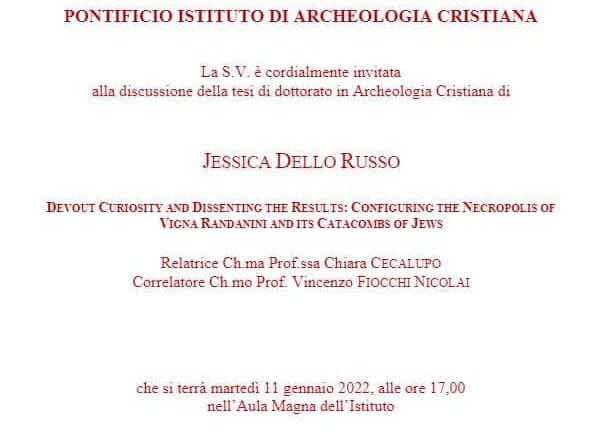International Catacomb Society Executive Board Member Jessica Dello Russo successfully defended her dissertation at the Pontifical Institute of Christian Archaeology in Rome on 11 January 2022, at 5 p.m. (CET). Dello Russo's thesis, "Devout Curiosity and Dissenting Results: Configuring the Necropolis of Vigna Randanini and Its Catacombs of Jews" incorporates new data and archival materials into close analysis of a cemetery of the Late Ancient era on the via Appia Antica just outside of Rome. For more information, please visit this link. The text of Dr. Dello Russo's presentation is below (in Italian).
Discorso di Jessica Dello Russo (11 gennaio 2022).
Grazie a tutti voi per la vostra presenza alla discussione della mia tesi di dottorato in Archeologia Cristiana. Sono particolarmente grata al mio supervisore, la prof.ssa Chiara Cecalupo, e a tutto il corpo accademico del PIAC per avermi seguito in questa ricerca e per questa occasione di parlarne. Nei venti minuti a mia disposizione, voglio condividere con voi le principali domande che ho cercato di affrontare nella mia tesi, “Curiosità devota e risultati dissenzienti nel configurare la Necropoli della Vigna Randanini e le sue Catacombe degli Ebrei”. Una sintesi dettagliata di duecentocinquanta pagine di testo densamente informativo non è possibile nei tempi concessi. Quindi, arrivo subito al contesto della ricerca e ai motivi per cui credo che queste domande siano importanti per noi nel 2022 e dove mi hanno portato nella stesura di questo lavoro. Nella’ piu’ ampia panoramica, il filo delle indagini seguite riguarda principalmente la lunga vita ultraterrena - cioe’, il riutilizzo, la spoliazione, e la riscoperta - di reperti di epoca romana che attestano alla presenza di ebrei nella Roma antica e altomedievale. Nello stato attuale della nostra conoscenza, la maggior parte di questi reperti deriva da cimiteri sotterranei di epoca tardo antica noti come "catacombe". Nella mia tesi, mi concentro sulle vicende storiche di un complesso cimiteriale in particolare, quello conosciuto piu’ spesso in epoca moderna come “la catacomba di Vigna Randanini”, sul lato sinistra della via Appia Antica quasi di fronte alla basilica di S. Sebastiano. Da quanto possiamo capire dalle ricognizioni e indagini già fatte fino ad oggi, almeno qualche migliaia di seguaci della fede giudaica nella Roma tardoantica - già nel’ terzo secolo ma soprattutto nel secolo quarto - hanno fatto uso di reti cimiteriali sotterranee come quello di Vigna Randanini per la loro sepoltura. Ecco a sinistra una delle piante cosiddette “tradizionali” della distribuzione dei principali cimiteri cristiani ed ebraici in zona Appia. Alcuni sono conosciuti dai nomi dei cimiteri collettivi notati nelle fonti letterarie tardoantiche e medievali, ed altri che spesso portano i nomi dei proprietari del terreni sotto ai quali furono “scoperti” nella meta’ dell’ ottocento. In questa seconda categoria si trovano almeno due complessi funerari ipogei ancora accessibili, quelli di Vigna Cimarra e Vigna Randanini, che portano chiari segni di frequentazione ebraica nella tarda antichita’. “Collettivo” naturalmente non vuol dire né uniforme, né monotona. Ma resta il fatto che in almeno sei aree sepolcrali antiche a Roma si trovavano nuclei concentrati di tombe demarcate con gli stessi motivi e con le stesse modalità epigrafiche che manifestano l’ identità ebraica dei defunti ivi sepolti. Ripeto, non tutte e non sempre le tombe in questi luoghi ce ne hanno questi segni di appartenenza ad una collettività sociale. Ma diventano elementi unificanti tra siti abbastanza distanti tra di loro. Di più, anche quando questi siti sepolcrali come il complesso catacombale di Vigna Randanini sembrano per la maggior parte strutturalmente identici ai cimiteri utilizzati dai cristiani ed altri gruppi collettivi - largamente detto, ogni luogo, al di là della questione della sua proprietà, ha le sue particolarità - questi segni identificativi non sono state registrati nei cimiteri intensamente sfruttati da gente di fede cristiana, come sappiamo anche dalle testimonianze letterarie dal terzo secolo in poi. Certo, per molti di voi, non c’e’ nessuna novita’ nelle cose che v’ho appena detto. Sostanzialmente, ripeto quello che mi e’ stato detto durante le lezioni al PIAC e in tante pubblicazioni dell’istituto stesso. Sulle cosiddette “catacombe ebraiche”, ovvero di gente che riconosce la Legge mosaica e le osservanze ebraiche, ormai c’e’ una bibliografia specifica, sempre in aggiornamento, e qui mi piace ricordare lo stretto coinvolgimento del PIAC nella realizzazione del un testo fondamentale della disciplina, il Corpus Inscriptionum Iudaicarum, che me accompagno’ per tutto il percorso della mia ricerca. Si vede quanta strada ha fatto la mia copia personale di questo libro! Dopo anni di relativa incuria di questi cimiteri non cristiani in epoca post-unitaria, oggi molte delle cosiddette “catacombe ebraiche” d’Italia - almeno quelle che hanno sopravvissuto il nuovo sacco di Roma da parte dai palazzinari ed altri protagonisti della speculazione edilizia nella capitale - sono diventate oggetti di studi specialistici e multidisciplinari. A questo crescente corpus di dati, la mia tesi fornisce nuovi dati d’archivio - vero che alcune cose ho gia’ pubblicato in altre sedi, ma ora sono rilette con molto attenzione ed arricchite da altre fonti inedite o mal note. Ma a parte i nuovi dati condivisi, e la revisioni delle fonti storiografiche con delle osservazioni originali, integrati con approfondimenti sullo sviluppo topografico-strutturale del complesso stesso, ho dovuto affrontare nella tesi una sfida inaspettata. C'è un grosso bagaglio nelle relazioni ebraiche-cattoliche, esemplificativo di una sistematica repressione degli ebrei nella società romana in molti momenti della storia. Sono vicende a lungo descritte e denunciate, ma solo occasionalmente in maniera veramente approfondita e bilaterale, che le teorie socio culturali fino ad oggi raramente forniscono.
Quindi, ho dovuto occuparmi di tanti argomenti del passato, con lo scopo non di polemizzare, ma invece di capire e di pronunciare su come siamo arrivati oggi a identificare certi reperti e alcuni interi complessi strutturali come “ebraici”. La domanda principale divento’: Come sono state contestualizzate le catacombe degli ebrei nella storia complessiva degli scavi a Roma? Nello specifico per il sito di Vigna Randanini: mi chiedevo come mai iniziamo a “vedere” le “sue” catacombe come un complesso cimiteriale ebraico solo nel 1859, dopo almeno qualche secolo di spoliazione e di riutilizzo dei residui archeologici del luogo. A cominciare, la “decisione fatale” al momento della riscoperta, chi l’ha presa? Fu Giovanni Battista de Rossi, il cosiddetto “fondatore della disciplina di archeologia cristiana”. E cosi’ con questa realizzazione, de Rossi divento’ il vero protagonista del mio studio, anche se di catacombe ebraiche ha pubblicato poco - la maggior parte dei suoi appunti su questi resti monumentali sono rimasti inediti fino al momento in cui molti furono inclusi nel primo volume di CIJ. Ma egli stesso segui’ da vicino le moderne fortune di questo sito. Come membro della Commissione Consultiva di Archeologia, fu un accanito sostenitore dell’ idea di mantenere questa catacomba degli ebrei aperta e intatta, come le catacombe prese in cura dall’allora CDAS. Disse il de Rossi stesso, “le antichità ebraiche sono intimamente connesse a quelle cristiane”. E seguendo le sue orme, ho cercato di manifestare in questo studio come l'indagine archeologica sull'identità ebraica a Roma fosse importante per gli archeologi cristiani del XIX e XX secolo e direi oggi più che mai. In una lettera pubblicata in una rivista americana nel 1980, il padre barnabita Umberto Maria Fasola descrivi’ così il coinvolgimento di de Rossi e i suoi immediati successori nella nascente “archeologia ebraica” a Roma: “Gli archeologi vaticani (cioè quelli coinvolti nel CDAS) li scoprirono, li esplorarono, li restaurarono, e ne scrissero”, sempre in riferimento ai cimiteri ebraici antichi. Per me, la catacomba di Vigna Randanini era un sito ideale per indagare sulla "validità" degli studi di de Rossi, dato che gli ultimi scavi eseguiti sul luogo risalgono alla seconda meta’ dell’ ottocento. Complessivamente, come si vede dall’elenco dei capitoli, ho pensato di strutturare la tesi come una “storia culturale” del sito, fornita di dati non solo archeologiche ma anche di piu’ ampie prospettive storiche. Questa decisione fu sempre ispirata dall’esempio del de Rossi, che in modo magistrale, intrecciò la narrazione cronologica dei fatti con giudizi scientifici e descrittivi. Così si evidenzia nell'organizzazione del mio testo come la catacomba di Vigna Randanini nella seconda meta’ dell’ottocento si trasformo’ da “peculiarità archeologica” non ben definita ad essere un sito di chiara se non proprio “classica” frequentazione ebraica. Quello che mi ha piu’ colpito non è la cosiddetta “magia” dell'intuizione di de Rossi, ma una solida consapevolezza da parte sua di quasi un millennio e mezzo di letteratura e altre fonti relative ai cimiteri e ad altre attestazioni dei monumenti antichi a Roma. Ma de Rossi aveva la mentalità dell'archeologo di guardare oltre il quadro letterario, e così accettò senza scrupoli la designazione ebraica della catacomba di Vigna Randanini scoperta nel 1859. E non era un sentenza pro forma: abbiamo la preziosa testimonianza di Randanini stesso che “ogni volta che trovavo una nuova iscrizione, Lei (de Rossi) veniva a farne una copia”.
Se ci fosse qualcosa di cristiano, oppure una marcata presenza cosiddetta “pagana”, difficile immaginare che questi dettagli poterono sfuggire all’attenzione di de Rossi. E’ importante aggiungere a questo discorso le attività di quei studiosi profondamente influenzati dal lavoro di de Rossi sul campo. Prima di tutto, e’ per richiamare attenzione specificamente al coinvolgimento degli ebrei allo studio del cimitero. Per molti anni, furono limitati al ruolo di consulenti agli studiosi cattolici per questioni di lingua, costumi, e letteratura ebraica. Tuttavia, singoli studiosi ebraici poterono accedere alle catacombe, ed incontrare il de Rossi per averne notizie. Fino alla sua morte nel 1894, era il punto di riferimento per informazioni sulle antichità ebraiche a Roma, nello stesso tempo incoraggiando il suo allievo, Orazio Marucchi, di "specializzarsi" su questo campo.
Non temo che il mio discorso solo ripete un racconto gia’ detto mille volte. L’esclamazione di un collega ebreo ha sintetizzato il valore dell’approccio: "Essa (cioe’ l'esplorazione iniziale di siti ebraici antichi a Roma) era un’ iniziativa cattolica!" Spero di essere riuscita a dimostrare nel mio studio che il progetto “Roma Sotterranea Cristiana” di de Rossi era una svolta prevalentemente positiva per la nascita di “archeologia giudaica” a Roma. Non si scusa il fatto che a Roma la disciplina rimase per molto tempo un “appendice” all'attività di archeologia cristiana, e che il de Rossi stesso perpetua nei suoi scritti molte formulazioni dogmatiche di supersessionismo. Ma guardando le catacombe tramite gli occhi di de Rossi, ho cominciato ad apprezzare il coraggio di questo studioso romano, questo “pio figlio della chiesa”, di accettare la complicata storia strutturale delle catacombe, e parlare delle loro attualita’. Questi approcci sono ancora validissimi per lo studio archeologico del cimitero di Vigna Randanini. Lasciamo, dunque, le catacombe di Vigna Randanini come “ebraiche” - finche’ possiamo seguire attentamente sulle orme di de Rossi ed intraprendere uno scavo scientifico del sito con criteri moderni, non speculativi. Grazie!








